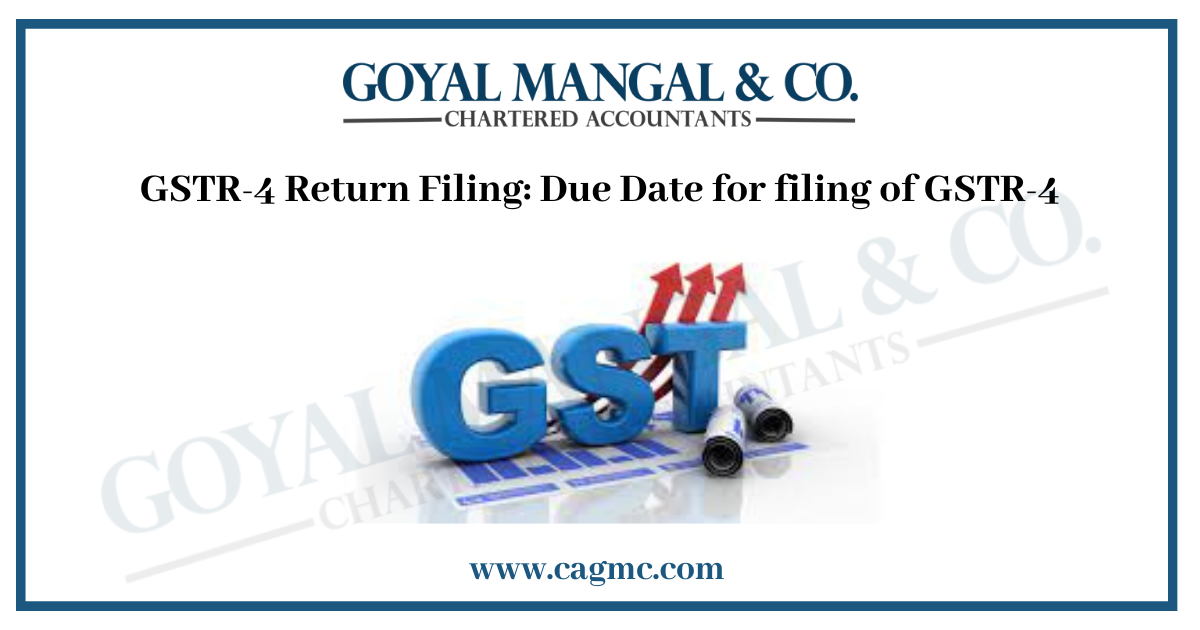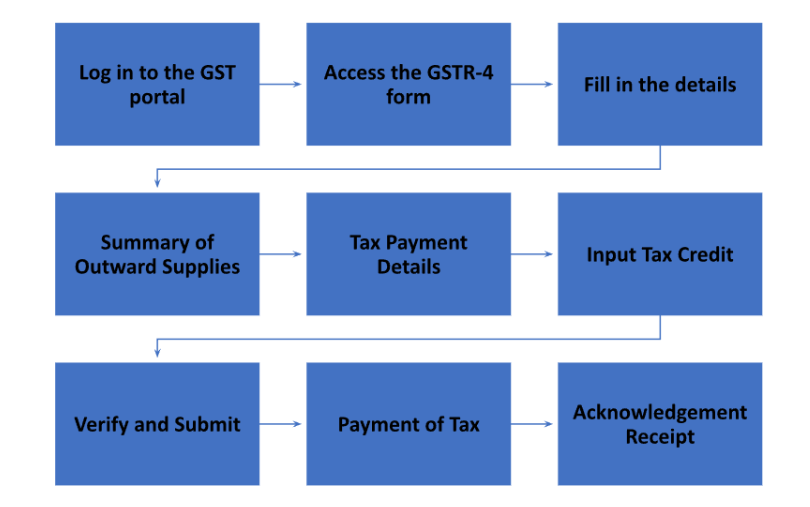
GSTR-4 Return Filing is an essential process in the Goods and Services Tax (GST) regime that businesses need to comply with. Under GST, GSTR-4 refers to the quarterly return filed by taxpayers registered under the Composition Scheme. This scheme is designed to provide relief to small businesses by offering a simplified tax compliance process. GSTR-4 return includes details such as turnover, tax paid, and the summary of inward and outward supplies. It is crucial to file GSTR-4 accurately and on time to ensure compliance with GST regulations and avoid penalties. By filing GSTR-4, businesses can report their tax liabilities and claim input tax credit on their purchases. It is important to note that the due date for filing GSTR-4 may vary, and failure to file within the specified timeframe can lead to consequences such as penalties and interest charges.
| Table of Content |
Definition and Applicability of GSTR-4
GSTR-4 is a quarterly return filed by businesses registered under the Composition Scheme of the Goods and Services Tax (GST) system in India. It is designed to simplify the tax compliance process for small businesses with a turnover limit specified by the government. Only taxpayers who are registered under the Composition Scheme and meet the prescribed turnover threshold are required to file GSTR-4. This return form allows composition taxpayers to report summarized tax liabilities, pay the applicable tax, and maintain compliance with GST regulations. Timely and accurate filing of GSTR-4 is crucial for businesses registered under the Composition Scheme to fulfill their GST obligations.
Who Should File GSTR-4?
GSTR-4 should be filed by businesses that meet the following criteria:
- Registered under the Composition Scheme: GSTR-4 is specifically for taxpayers who have opted for the Composition Scheme under the Goods and Services Tax (GST) regime. The Composition Scheme is available to small businesses with a turnover limit specified by the government.
- Annual Turnover within the Prescribed Limit: The eligibility to file GSTR-4 is determined based on the annual turnover of the business. The turnover limit for composition taxpayers may vary from state to state, but it generally ranges from 1.5 crore INR to 1.5 crores to 2 crores INR, as specified by the government.
Key Components of GSTR-4 Return
The key components of the GSTR-4 return, which is filed by taxpayers registered under the Composition Scheme, include:
- Basic Details:
-
-
- Legal name of the taxpayer
- Goods and Services Tax Identification Number (GSTIN)
- Period of the return (quarterly)
-
- Outward Supplies:
-
-
- Summary of outward supplies made during the quarter
- Details of inter-state supplies (B2B and B2C)
- Details of intra-state supplies (B2B and B2C)
-
- Consolidated Tax Payment:
-
-
- Calculation of tax payable on outward supplies
- Tax paid under the composition scheme
- Details of tax liability for the quarter
-
- Input Tax Credit:
-
-
- Input tax credit (if any) claimed by the taxpayer for the quarter
- Details of inward supplies attracting reverse charge (if applicable)
-
- Late Fee and Interest:
-
- Information regarding any late fee or interest paid on tax liabilities, if applicable
Due Date for Filing GSTR-4
Adhering to the due date for filing GSTR-4 is of utmost importance for businesses registered under the Composition Scheme. Timely filing ensures compliance with tax regulations and helps maintain a smooth flow of business operations. It also allows for accurate reporting of tax liabilities, preventing any errors or discrepancies in the return. Additionally, timely filing of GSTR-4 avoids penalties, interest charges, and any potential legal consequences.
- Current Due Date for Filing GSTR-4 – The due date for filing the GSTR 4 is 30th April of the following financial year. For example, for the financial year 2022-23, the due date for filing the GSTR 4 would be 30th April 2023
Consequences of Late Filing
Consequences of Late Filing of GSTR-4, the quarterly return for businesses registered under the Composition Scheme, can include:
- Penalties: Late filing may attract penalties as prescribed by the tax authorities. The penalty amount can vary based on the tax laws and regulations applicable in the specific jurisdiction. The penalty is typically levied per day of delay from the due date until the return is filed. The late fee for GSTR-4, which is a quarterly return filed by Composition Scheme taxpayers under the Goods and Services Tax (GST) in India, was INR 200 per day (INR 100 for CGST + INR 100 for SGST). However, please note that tax regulations and fees may have changed after my last update, so it is essential to verify the current late fee with the official GST portal or a reliable source.
- Interest Charges: Late filing of GSTR-4 may result in interest charges on the tax liabilities. The interest rate is usually specified by the tax authorities and is calculated on the outstanding tax amount for the period of delay. These interest charges can accumulate over time until the return is filed and the tax liability is paid.
- Loss of Input Tax Credit: Delayed filing can impact the taxpayer’s ability to claim input tax credit on eligible purchases. Input tax credit is time-bound and must be claimed within the prescribed deadlines. Late filing may result in the loss of input tax credit for that particular period, reducing the tax benefits available to the taxpayer.
- Non-Compliance Issues: Late filing of GSTR-4 can lead to non-compliance with GST regulations. This may trigger increased scrutiny from tax authorities, potentially resulting in audits or investigations. Non-compliance can also tarnish the taxpayer’s compliance record and create a negative impression with regulatory bodies.
Procedure for Filing GSTR-4
- Step-by-Step Guide to File GSTR-4 Return

Filing GSTR-4 return involves the following steps:
-
- Log in to the GST portal: Online filing –Visit the official GST portal (www.gst.gov.in) and log in using your valid credentials.
- Access the GSTR-4 form: Navigate to the “Returns Dashboard” and select the financial year and the respective quarter for which you want to file GSTR-4.
- Fill in the details: Provide the required information in the GSTR-4 form. This includes basic details such as legal name, GSTIN, and composition scheme details.
- Summary of Outward Supplies: Enter the summary of outward supplies made during the quarter, including details of inter-state and intra-state supplies.
- Tax Payment Details: Calculate the tax payable on outward supplies and enter the tax liability under the composition scheme.
- Input Tax Credit: If eligible, claim any input tax credit available for the quarter and provide the necessary details.
- Verify and Submit: Review the filled-in information and ensure its accuracy. Once verified, submit the GSTR-4 return.
- Payment of Tax: Pay the tax liability, if any, through the online payment options available on the GST portal.
- Acknowledgement Receipt: After successful submission and payment, an acknowledgement receipt with an Application Reference Number (ARN) will be generated.
- Preparing the Necessary Documents and Information
Before filing GSTR-4, ensure that you have the following documents and information readily available:
-
- GSTIN: Goods and Services Tax Identification Number (GSTIN) of the business.
- Turnover Details: Accurate turnover details for the quarter, including inter-state and intra-state supplies.
- Tax Calculation: Calculation of tax payable under the composition scheme.
- Input Tax Credit Details: Information on any eligible input tax credit claimed for the quarter.
- Supporting Documents: Keep relevant invoices, purchase records, and other supporting documents as per the GST regulations.
- Online and Offline Modes of Filing
GSTR-4 return can be filed using both online and offline modes. Here’s a brief explanation of each:
- Online Filing: The preferred method is filing GSTR-4 online through the official GST portal. Log in to the portal, fill in the required details, and submit the return electronically. Payment of tax liability can also be made online through the portal.
- Offline Filing: Taxpayers can use offline utilities, such as the GSTR-4 offline tool, to prepare their return offline. Once prepared, the return can be uploaded on the GST portal using the Offline Tool. However, payment of tax liabilities must be made online through the portal.
Common Mistakes to Avoid in GSTR-4 Return Filing
When filing the GSTR-4 return, it is important to avoid the following common mistakes:
-
- Failure to report all relevant sales and purchases: Ensure that all sales made and purchases incurred during the quarter are accurately reported in the GSTR-4 return. Missing out on any transactions can lead to discrepancies in tax calculations and potential compliance issues.
- Incorrect reporting of taxable turnover: Calculate the taxable turnover correctly, considering only the eligible supplies for the composition scheme. Be aware of any exempted or non-taxable supplies that should not be included in the taxable turnover calculation.
- Inadequate documentation and record-keeping: Maintain proper documentation and records of all invoices, purchase bills, and other relevant documents supporting the reported transactions. Inadequate documentation can result in challenges during audits or verifications.
- Failure to reconcile data: Reconcile the GSTR-4 return data with other financial records, such as sales registers and purchase invoices. Any discrepancies should be resolved and corrected before submitting the return.
- Incorrect input tax credit claims: Claim input tax credit accurately and only for eligible inputs. Ensure that all input tax credits claimed are supported by valid invoices and comply with the applicable GST rules.
- Late filing: Avoid late filing of GSTR-4 return as it can lead to penalties and interest charges. Stay updated with the due dates and submit the return within the prescribed timeframe.
- Lack of understanding of composition scheme rules: Familiarize yourself with the rules and regulations governing the composition scheme. Stay updated with any changes or notifications issued by the tax authorities to ensure compliance with the scheme’s requirements.
Conclusion
So, adhering to the due date for filing GSTR-4 is crucial for businesses registered under the Composition Scheme. To ensure successful GSTR-4 return filing, businesses should prepare the necessary documents and information in advance, avoid common mistakes, and consider seeking professional assistance when needed. By understanding the procedure, adhering to the due date, and maintaining accurate records, businesses can navigate the GSTR-4 return filing process smoothly and stay compliant with GST regulations. Timely and accurate filing of the GSTR-4 return ensures compliance with GST regulations, avoids penalties and interest charges, and maintains smooth tax operations. By filing GSTR-4 on time, businesses can report their tax liabilities, claim input tax credit, and fulfill their GST obligations effectively.


